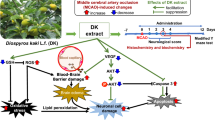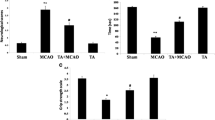Abstract
Centella asiatica has been used as psychoactive and antioxidant herbal medicine since ancient time. The present study was design to evaluate the preventive role of ethanolic extract of C. asiatica in middle cerebral artery occlusion (MCAO) in rats. Male Wistar rats were gavaged orally with C. asiatica extract (100, 200 and 300 mg/kg body weight once daily) for 21 days and thereafter subjected to right MCAO for 2 h followed by 22-h reperfusion. Brain injury was evaluated by 2,3,5-triphenyltetrazolium chloride and hematoxylin and eosin staining. Behavioural outcomes as neurological deficit, rota rod test, and grip strength were assessed. In addition, lipid peroxidation, enzymatic and non enzymatic antioxidants were analyzed to assess the oxidative stress. Our results revealed that C. asiatica administration greatly improved neurobehavioral activity and diminished infarction volume along with the restored histological morphology of brain in MCAO rats. Furthermore, supplementation with this extract to MCAO group has reduced the level of thiobarbituric acid reactive species, restored glutathione content and augmented the activities of antioxidant enzymes—catalase, glutathione peroxidase, glutathione reductase, glutathione-S-transferase and superoxide dismutase in a dose-dependent manner in ischemic rats. The remarkable antioxidant activity of C. asiatica may be attributed to its bioactive triterpenes, asiatic acid, asiaticoside, madecassic acid and madecosside and may be translated to clinical level for prevention of ischemic stroke.



Similar content being viewed by others
References
Dirnagl U, Iadecola C, Moskowitz AM (1999) Pathobiology of ischaemic stroke: an integrated view. Trends Neurosci 22:391–397
Collino M, Aragno M, Mastrocola R et al (2006) Modulation of the oxidative stress and inflammatory response by PPAR-gamma agonists in the hippocampus of rats exposed to cerebral ischemia/reperfusion. Eur J Pharmacol 530:70–80
Chan PH (2004) Reactive oxygen radicals in signaling and damage in the ischemic brain. J Cereb Blood Flow Metab 21:2–14
Ahmad A, Khan MM, Hoda MN et al (2011) Quercetin protects against oxidative stress associated damages in a rat model of transient focal cerebral ischemia and reperfusion. Neurochem Res 36:1360–1371
Khan MM, Ahmad A, Ishrat T et al (2009) Rutin protects the neural damage induced by transient focal ischemia in rats. Brain Res 1292:123–135
Saleem S, Ahmad M, Ahmad AS et al (2006) Behavioral and histologic neuroprotection of aqueous garlic extract after reversible focal cerebral ischemia. J Med Food 9:537–544
Saleem S, Ahmad M, Ahmad AS et al (2006) Effect of saffron (Crocus sativus) on neurobehavioral and neurochemical changes in cerebral ischemia in rats. J Med Food 92:246–253
Salim S, Ahmad M, Zafar KS, Ahmad AS, Islam F (2003) Protective effect of Nardostachys jatamansi in rat cerebral ischemia. Pharmacol Biochem Behav 74:481–486
Sharma PV (1992) Dravyaguna Vignana, 13th edn. Chaukhamba Publications Vishwa Bharati Academy, New Delhi, India
Flora SJ, Gupta R (2007) Beneficial effects of Centella asiatica aqueous extract against arsenic-induced oxidative stress and essential metal status in rats. Phytother Res 21:980–988
George M, Joseph L, Ramaswamy (2009) Anti-allergic, anti-pruritic, and anti-inflammatory activities of Centella asiatica extracts. Afr J Tradit Complem Altern Med 6:554–559
Hashim P, Sidek H, Helan MH, Sabery A, Palanisamy UD, Ilham M (2011) Triterpene composition and bioactivities of Centella asiatica. Molecules 16:1310–1322
Dhanasekaran M, Holcomb LA, Hitt AR, Tharakan B, Porter JW, Young KA, Manyam BV (2009) Centella asiatica extract selectively decreases amyloid beta levels in hippocampus of Alzheimer’s disease animal model. Phytother Res 23:14–19
Haleagrahara N, Ponnusanny K (2010) Neuroprotective effect of Centella asiatica extract (CAE) on experimentally induced Parkinsonism in aged Sprague–Dawley rats. J Toxicol Sci 35:41–47
Bederson JB, Pitts LH, Tsuji M, Nishimura MC, Davis RL, Bartkowski H (1986) Rat middle cerebral artery occlusion: evaluation of the model and development of a neurologic examination. Stroke 17:472–476
Yousuf S, Atif F, Ahmad M, Hoda MN, Khan MB, Ishrat T, Islam F (2007) Selenium plays a modulatory role against cerebral ischemia-induced neuronal damage in rat hippocampus. Brain Res 1147:218–225
Ali A, Ahmad FJ, Pillai KK, Vohora D (2004) Evidence of the antiepileptic potential of amiloride with neuropharmacological benefits in rodent models of epilepsy and behaviour. Epilepsy Behav 5:322–328
Sommer B, Barbieri S, Hofele K et al (2000) Mouse models of alpha-synucleinopathy and Lewy pathology. Exp Gerontol 35:1389–1403
Nakayama H, Ginsberg MD, Dietrich WD (1988) (S)-Emopamil, a novel calcium channel blocker and serotonin S2 antagonist, markedly reduces infarct size following middle cerebral artery occlusion in rat. Neurology 38:1667–1673
Islam F, Zia S, Sayeed I, Zafar KS, Ahmad AS (2002) Selenium induced alteration on lipids, lipid peroxidation, and thiol group in circadian rhythm centers of rat. Biol Trace Elem Res 90:1–12
Jollow DJ, Mitchell JR, Zampaghone N, Gillete JR (1974) Bromobenzene induced liver necrosis: protective role of glutathione and evidence for 3, 4-bromobenzene oxide as the hepatotoxic intermediate. Pharmacology 11:161–169
Claiborne A (1985) Catalase activity. In: Green Wald RA (ed) CRC hand book of methods for oxygen radical research. CRC Press, Boca Raton, pp 283–284
Mohandas J, Marshall JJ, Duggin GG, Horvath JS, Tiller D (1984) Differential distribution of glutathione and glutathione related enzymes in rabbit kidneys: possible implication in analgesic neuropathy. Cancer Res 44:5086–5091
Habig WH, Pabst M, Jakoby WB (1974) Glutathione S-transferase: the first enzymatic step in mercapturic acid formation. J Biol Chem 249:7130–7139
Stevens MJ, Obrosova I, Cao X, Huysen CV, Green DA (2000) Effect of DL-alpha- lipidic acid on peripheral nerve conduction, blood flow, energy metabolism and oxidative stress in experimental diabetic neuropathy. Diabetes 49:1006–1015
Lowry OH, Rosenbrough NJ, Farr AL, Randall RJ (1951) Protein measurement with the folin phenol reagent. J Biol Chem 193:265–275
Bora KS, Shri R, Monga J (2011) Cerebroprotective effect of Ocimum gratissimum against focal ischemia and reperfusion-induced cerebral injury. Pharm Biol 49:175–181
Cui J, Holmes EH, Greene TG, Liu PK (2000) Oxidative DNA damage precedes DNA fragmentation after experimental stroke in rat brain. FASEB J 14:955–967
Doyle KP, Simon RP, Stenzel-Poore MP (2008) Mechanisms of ischemic brain damage. Neuropharmacology 55:310–318
Khan MM, Ishrat T, Ahmad A et al (2010) Sesamin attenuates behavioral, biochemical and histological alterations induced by reversible middle cerebral artery occlusion in the rats. Chemi-Biol Interact 183:255–263
Solenski NJ, diPierro CG, Trimmer PA, Kwan AL, Gregory A, Helms GA (2002) Ultrastructural changes of neuronal mitochondria after transient and permanent cerebral ischemia. Stroke 33:816–824
Liszczak TM, Hedley-Whyte ET, Adams JF et al (1984) Limitations of tetrazolium salts in delineating infarcted brain. Acta Neuropathol 65:150–157
Chang Y, Hsieh CY, Peng ZA, Yen TL, Hsiao G, Chou DS, Chen CM, Sheu JR (2009) Neuroprotective mechanisms of puerarin in middle cerebral artery occlusion-induced brain infarction in rats. J Biomed Sci 16:9
Love S (1999) Oxidative stress in brain ischemia. Brain Pathol 9:119–131
Sinha K, Degaonkar MN, Jagannathan NR, Gupta YK (2001) Effect of melatonin on ischemia reperfusion injury induced by middle cerebral artery occlusion in rats. Eur J Pharmacol 428:185–192
Imam SZ, Ali SF (2000) Selenium, an antioxidant, attenuates methamphetamine-induced dopaminergic toxicity and peroxynitrite generation. Brain Res 855:186–191
Wu HW, Li HF, Wu XY, Zhao J, Guo J (2008) Reactive oxygen species mediate ERK activation through different RAF-1-dependent signaling pathways following cerebral ischemia. Neurosci Lett 432:83–87
Baez S, Segura-Aguilar J, Widersten M, Johansson AS, Mannervik B (1997) Glutathione transferases catalyse the detoxication of oxidized metabolites (o-quinones) of catecholamines and may serve as an antioxidant system preventing degenerative cellular processes. Biochem J 324:25–28
Cheng Z, He W, Zhou X, Lv Q, Xu X, Yang S, Zhao C, Guo L (2011) Cordycepin protects against cerebral ischemia/reperfusion injury in vivo and in vitro. Eur J Pharmacol 664:20–28
Ramanathan M, Sivakumar S, Anandvijayakumar PR, Saravanababu C, Pandian PR (2007) Neuroprotective evaluation of standardized extract of Centella asiatica in monosodium glutamate treated rats. Indian J Exp Biol 45:425–435
Orhan IE (2012) Centella asiatica (L.) Urban; from traditional medicine to modern medicine with neuroprotective potential. Evid Based Complement Altern Med 2012:946259. doi:10.1155/2012/946259
Lee KY, Bae ON, Serfozo K, Hejabian S, Moussa A, Reeves M, Rumbeiha W, Fitzgerald SD, Stein G, Baek SH, Goudreau J, Kassab M, Majid A (2012) Asiatic acid attenuates infarct volume, mitochondrial dysfunction, and metalloproteinase-9 induction after focal cerebral ischemia. Stroke 43:1632–1638
Xu CL, Wang QZ, Sun LM, Li XM, Deng JM, Li LF, Zhang J, Xu R, Ma SP (2012) Asiaticoside: attenuation of neurotoxicity induced by MPTP in a rat model of Parkinsonism via maintaining redox balance and up-regulating the ratio of Bcl-2/Bax. Pharmacol Biochem Behav 100:413–418
Soumyanath A, Zhong YP, Gold SA, Yu X, Koop DR, Bourdette D, Gold BG (2005) Centella asiatica accelerates nerve regeneration upon oral administration and contains multiple active fractions increasing neurite elongation in vitro. J Pharm Pharmacol 57:1221–1229
Acknowledgments
The author (R. Tabassum) is highly thankful to UGC, Govt. of India for financial help.
Conflict of interest
Authors declare that there is no conflict of interest involved with this work.
Author information
Authors and Affiliations
Corresponding author
Electronic supplementary material
Below is the link to the electronic supplementary material.
Rights and permissions
About this article
Cite this article
Tabassum, R., Vaibhav, K., Shrivastava, P. et al. Centella asiatica attenuates the neurobehavioral, neurochemical and histological changes in transient focal middle cerebral artery occlusion rats. Neurol Sci 34, 925–933 (2013). https://doi.org/10.1007/s10072-012-1163-1
Received:
Accepted:
Published:
Issue Date:
DOI: https://doi.org/10.1007/s10072-012-1163-1




